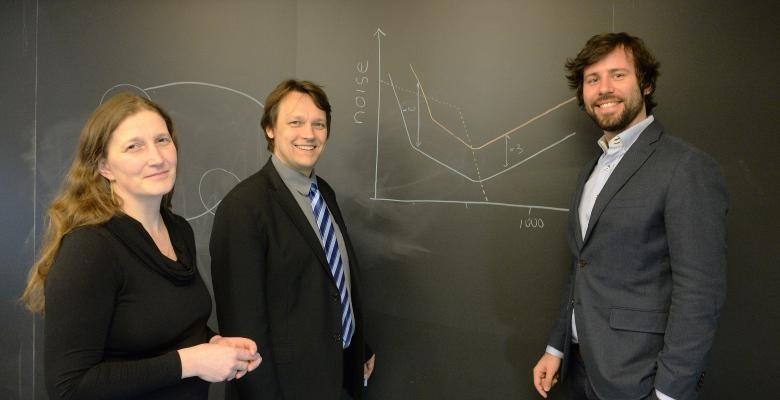Columbia Astrophysicists on the Unprecedented Discovery of Gravitational Waves

Three Columbia astrophysicists are celebrating a major scientific discovery – the detection of gravitational waves. The finding, made by the LIGO Scientific Collaboration in which the Columbia team plays an integral role, confirms a major prediction in Albert Einstein’s general theory of relativity, published a century ago.
“As scientists, we are always looking for new information,” said Szabolcs Márka, the Walter O. LeCroy, Jr. Associate Professor of Physics. “Sometimes we know what we are looking for and we find it. Sometimes something has been predicted, but we haven’t seen it and we seek the discovery, the observation.”
Gravitational waves are ripples in the fabric of space-time emitted by enigmatic processes, such as the merger of black holes or neutron stars. These waves might travel a billion light years from a distant galaxy and eventually reach Earth. Until now, scientists could study how matter behaved around massive objects and only infer that black holes existed. The discovery represents a new and different way of studying the universe.
On Thursday, the National Science Foundation announced the success of its experiment to confirm the existence of gravitational waves. Conceived and built by MIT and Caltech, the effort was funded by the NSF and aided by the research of hundreds of scientists from institutions around the world—including Columbia, where Márka and Physics Lecturer Imre Bartos and Astrophysicist Zsuzsanna Márka designed integral systems.
Michael Tuts, chair of Columbia’s Department of Physics, said, “The discovery of gravitational waves is on a par with the major discoveries of the last decade, like the Higgs Boson. It’s something that we’ve known—Einstein predicted it 100 years ago—but it’s taken us this long to finally be able to confirm it. Like the Higgs, I think this is Nobel-quality work.”
Below, Columbia scientists discuss the discovery and their role in it.
Q. What is the importance of this discovery?
A. Szabolcs Márka: We hoped that binary black holes would be out there, and LIGO discovered that they really exist, which is exciting in itself. Sometimes, though, scientists just keep looking to uncover things they never even fathomed could exist. Advanced LIGO has and will be the tool that allows us to uncover new knowledge we had no idea existed. Nobody has had access to the universe this way before. We are doing cosmic archaeology. We are looking so far back into the history of the unseen universe that it is the most awesome experience that I, as a scientist, could ever imagine.
Q. Can you describe the new discovery?
A. Bartos: We have, for the first time, detected gravitational wave signals that were produced during the final fraction of a second before two black holes merged and formed a single, even more massive and fast-spinning black hole. This sort of collision has been predicted but we’ve never actually observed it before. The data revealed that this event took place 1.3 billion years ago. We found that Einstein’s [theory of] general relativity worked well in predicting what we expect.
"We’ve always had our eyes on the stars. Now we can hear them too."
— Szabolcs Márka
Q. What is LIGO?
A. Zsuzsanna Márka: LIGO stands for the Laser Interferometer Gravitational-Wave Observatory, a detector network with two sites 1,865 miles apart, one in Livingston, La. and the other in Hanford, Wash. Each site holds large vacuum chambers connected with vacuum pipes arranged in an L shape with 2.5-mile arms. Lasers shoot beams along those lines and measure tiny displacements, smaller even than the size of the atoms the detector is built of.
Q. What is LIGO designed to discover?
A. Bartos: The main goal of detecting gravitational waves is to study unusual cosmic events involving black holes and others. Black holes, as the name implies, are dark. Since they don’t radiate anything else, it is very hard to learn about them or know where they are. In fact, up to this point we’ve only had indirect evidence that black holes exist at all. There should be millions and millions of black holes out there, but we have not directly observed them. We want to use black holes as gigantic cosmic laboratories where we can test physics that was untestable before. Gravitational waves will help us put together all the puzzle pieces that we have about objects in the universe to get a more complete picture of what’s out there and increase our understanding of how the cosmos evolved.
Q. What contributions did the Columbia University team make in this experiment?
A. Zsuzsanna Márka: Columbia built the complete timing system for advanced LIGO. Time is essential in figuring out the direction in which we hear two black holes colliding. Reliable timing is also essential in controlling the instrument. Nothing could work without it. Columbia was part of the team that built and switched on advanced LIGO. We will also continue to provide future upgrades.
Q. What makes this discovery exciting for you?
A. Szabolcs Márka: As human beings, we perceive and understand the universe through our senses. We see things. We hear things. We taste things. Our senses provide beautiful synergies and help us make sense of the world. Just imagine that one day you wake up with a new sense. Can you imagine how the world would change? This is what just happened to us. Humanity just woke up. We’ve always had our eyes on the stars. Now we can hear them too.